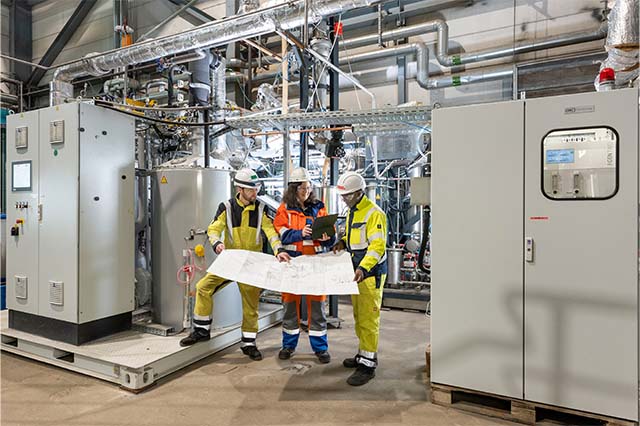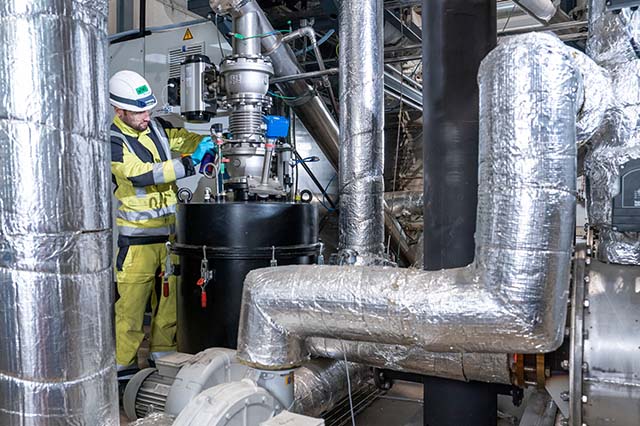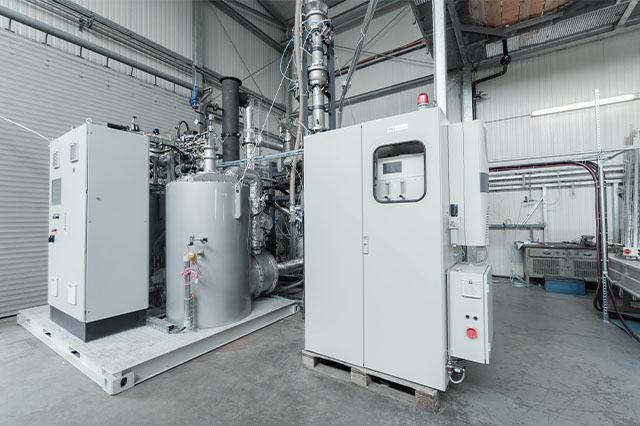Pilot plant for thermocatalytic reforming (TCR®) developed by Fraunhofer UMSICHT goes into operation at the RWE Innovation Center in Niederaussem.
A pyrolysis plant developed by Fraunhofer UMSICHT was put into operation at the RWE Innovation Center in Niederaussem. It uses biogenic residues and waste materials, in particular mixtures of various feedstocks such as sewage sludge or fermentation residues, to produce high-quality hydrocarbons. These can then be processed into low-CO2 fuels or other chemical products.



In order to achieve the climate targets, a significant reduction in greenhouse gas emissions is required in the short term. To this end, sustainable carbon sources, e.g. biomass, residues or CO2, are being tapped in order to integrate them into carbon cycles and convert them in industrial processes in a sustainable and CO2-neutral manner. RWE's goal is to further develop these alternative processes in order to bring them to commercial maturity. Natividad Jordan Escalona, project manager at RWE: »Das TCR® process is one that has a lot of potential to produce synthetic fuels. That's why we're testing this technology in Niederaussem to make it even more efficient and cost-effective.«
For this purpose, an innovative pyrolysis plant has now been commissioned at the RWE research site in Niederaussem as part of the ITZ CC joint project (see below). The research reactor developed by the Fraunhofer Institute UMSICHT operates on the principle of thermocatalytic reforming (TCR® process), a pyrolysis process with a downstream reforming step. The plant in Niederaussem converts sewage sludge into a hydrogen-rich gas, carbonizate and oil. However, other biogenic residues, such as fermentation residues from biogas plants, can also be used. The oil phase from the process can then be used for further processing into high-quality liquid hydrocarbons and fuels.
The resulting solid, a carbonizate similar to hard coal, is also being utilized: it is being used on a test basis in a high-temperature conversion plant that was also built by RWE as part of the project. The main aim here is to recover the phosphorus content from the sewage sludge. Depending on the feedstock, however, other product uses of the carbonate fraction are also possible, e.g. in soil applications, for the production of activated carbon or for hydrogen generation.
Johannes Neidel, project manager at Fraunhofer UMSICHT in Sulzbach-Rosenberg, says about the project goals: »Here in the test environment of the large power plant, we can further optimize and automate the TCR® plant. We are aiming at the utilization of biogenic residual and waste materials in a broad spectrum, resulting in high-quality products. A particular focus is on the one hand on the liquid hydrocarbons produced, which are in the form of oil with comparable properties to fossil crude oil, and on the other hand on stable long-term operation.«
The collaborative project ITZ CC
The Fraunhofer Institute for Environmental, Safety and Energy Technology UMSICHT based in Oberhausen, RWE Power AG and the Ruhr University Bochum (RUB) are cooperating in the project »ITZ CC« on innovation and technology demonstrators for the conversion and utilization of sustainable carbon sources (»Carbon Conversion (CC)«). Know-how, pilot plants and individual components as well as research and development work on carbon conversion and utilization are brought together. This project is funded by the Ministry of Economics, Industry, Climate Protection and Energy of the State of North Rhine-Westphalia.
The background to the joint project is the phase-out of coal-fired power generation by 2030, which calls for structural change in the lignite regions. The aim is to replace the existing fossil carbon economy with a new, more sustainable carbon economy with the help of technology innovations. In this way, industrial sites in NRW can be maintained and domestic industry can continue to be supplied with carbon-based raw materials in the future.
In the ITZCC, Fraunhofer UMSICHT is responsible for two subprojects: »Extraction of humic substances for various applications« and »Fuel production by co-pyrolysis.« The latter sub-project involved the installation of the pyrolysis plant.
Last modified:
